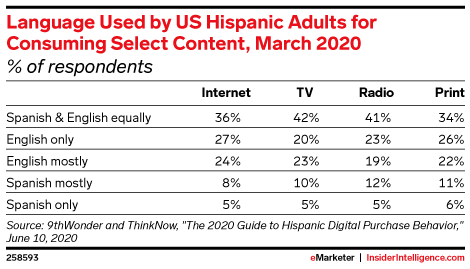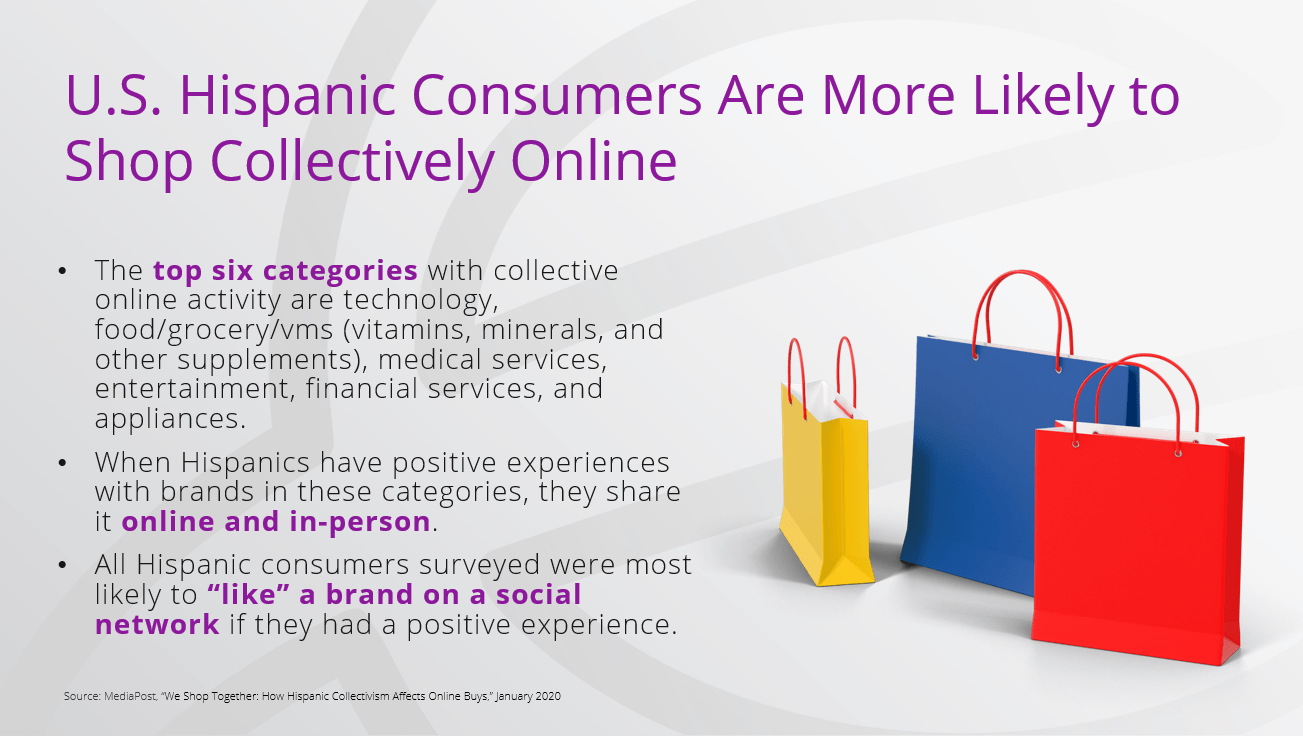Why is Spanish-Language Advertising Important in Hispanic Digital Marketing?
As more brands and businesses begin to recognize the importance of the U.S. Hispanic market, it’s never been a better time to get started with Hispanic digital marketing. While many people assume that Spanish-language marketing is as simple as translating English-language ads into Spanish, they couldn’t be more wrong. Continue reading for the full scoop on how and why you should be using Spanish-language ads to make meaningful connections with Latino consumers.
Here’s a recap of what we’ll be reviewing:
- Despite a rise in English proficiency, Spanish-Language messaging reigns supreme for Latino consumer engagement
- A collectivist culture often means that Latino marketing reaches the whole family -- making Spanish-Language ads a catalyst for forming brand connections
- The Spanish Language brings together a diverse Hispanic community and culture
- Amidst a push for diversity, Spanish-Language content and Latino representation is at the forefront
Questions or comments?
Contact us.
Despite a Rise in English Proficiency, Spanish-Language Messaging Reigns Supreme for U.S. Latino Consumer Engagement
A September 2020 Pew report found that 71% of Hispanics ages 5 and older were proficient in English -- up 12 percentage points since 2000. Additionally, a January 2020 survey of Hispanics ages 13 to 85 by the Collage Group found that roughly three-quarters said they speak English either “very well” (53%) or “well” (21%).
However, for U.S. Latino audiences, being proficient in English does not mean only speaking and understanding English. For instance, a March 2020
poll
from ThinkNow among Hispanics ages 18 to 64 examined language usage at home and found that those normally speaking Spanish only (12%) or Spanish mostly (23%) outnumbered those speaking English only (13%) or English mostly (17%), with the rest (35%) saying they speak the two languages equally.
An example of this can be seen in the growing Spanish-language podcast space among U.S. Hispanic audiences --
48%
of Hispanics who listened to podcasts at least monthly said half or more of the podcasts they listen to are in Spanish.
This may lead some to assume that Spanish-dominant Hispanics are the only ones who choose to listen to podcasts in Spanish. In actuality, U.S. Hispanics of varying Spanish-speaking levels have been giving Spanish-language podcasts a try as a way to connect with their culture or brush up on their Spanish abilities.
Whichever way you plan on reaching Latinos via digital marketing, knowing when to use your audience’s preferred language can be make or break -- it’s been found that messaging in Spanish that is targeted to Spanish-preferred audiences can generate a response rate
four to five times higher
than the same message in English!
A Collectivist Culture Often Means that Latino Marketing Reaches the Whole Family -- Making Spanish-Language Ads a Catalyst for Forming Brand Connections
Multigenerational Households
Hispanic consumers are a growing group that represents 20% of the U.S. population and $2 trillion in purchasing power -- making them an audience you cannot afford to miss out on connecting with.
That being said, understanding and respecting Hispanic cultural and family dynamics are crucial to making a mark with ads that are applicable and relevant for the whole family. For instance, many traditional U.S. Hispanic households are multigenerational, meaning that first, second, and third-generation Latinos live in the same household.
Oftentimes, Spanish Language First (SLF) family members tend to rely on English Language First (ELF) members to interpret English-language content and American culture. This can range from helping with online searches, translating web pages and ads, explaining brand options, and playing a vital role at every step of the purchase journey.
Collective Shoppers
In general, Hispanic consumers are more likely to shop collectively online, with younger bilingual/bicultural consumers driving the trend forward especially among younger age groups. A recent study showed that the top six categories with collective online activity are technology, food/grocery/vms (vitamins, minerals, and other supplements), medical services, entertainment, financial services, and appliances.
Having a positive experience with particular brands and businesses can go a long way, with Hispanic consumers often choosing to share their positive experiences with others online and in-person -- all Hispanics surveyed were most likely to “like” a brand on a social network if they had a positive experience.
Bilingual and Bicultural Latinos
While considering a Spanish-language strategy is a great start, knowing that not all Hispanic consumers are Spanish-dominant is key. By having a strong grasp of the bicultural and bilingual Hispanic consumer, business can do a better job of reaching them in-language and in-culture in a way that resonates.
Partnering with a Hispanic digital marketing agency who can authentically connect with this vital audience is a great way to use Latino marketing effectively and ensure successful Hispanic marketing campaigns for your business.
If you’re feeling confused about what all of these different Hispanic marketing terms mean, no worries -- we’ve got you covered with our free Intro to
Hispanic Marketing eBook.
The Spanish Language Brings Together a Diverse Hispanic Community and Culture
The U.S. Hispanic community consists of individuals from over 20 different Latin American countries, making this group incredibly diverse under the “Latino” umbrella term. From food, customs, slang, and more, there are many differences between Latinos in the U.S. -- but the Spanish language is a key component that connects the Hispanic community to one another.
Latinos come from a
high context culture, meaning that there are many complexities and nuances within the culture that can make it more difficult for people outside of it to understand.
This is one of the reasons why simply translating advertisements from English to Spanish does not cut it. In many ways, understanding Hispanic culture and values are just as important as using the right language when marketing to U.S. Latinos, since the culture and language is deeply interconnected.
When brands communicate with consumers in Spanish and/or with a firm understanding of Latino culture, they can resonate more deeply with Hispanic consumers by forming a stronger emotional appeal. Ultimately, reaching Latino consumers in-culture and in their preferred language allows businesses to stay ahead of the competition and make meaningful connections with growing audiences.
Amidst a Push for Diversity, Spanish-Language Content and Latino Representation is at the Forefront
Results from an Adobe research report show that 53% of Hispanic Americans feel their ethnicity is portrayed stereotypically in advertisements. The same report also showed that 61% of Americans find diversity in advertising important, and 38% of consumers are more likely to trust brands that do well with showing diversity in their ads.
Evidently, there is a major discrepancy between the demand for diverse ads and the actual execution of said diverse ads. From entertainment to tech and advertising, a demand for representation and inclusivity has led many industry leaders to acknowledge the importance of diverse Spanish-language content to meet audience expectations.
Podcasts Add More Spanish-Language Content
Digital audio and podcasts have surged in popularity in recent years, partly due to a trend that began in 2018 when established podcasters entered the Spanish-speaking domain along with an increased interest from brands and advertisers looking to advertise in Spanish. In 2020, a Voxnest report found that the number of monthly active Spanish-language podcasts grew by 94% during the first five months of the year.
Tech Devices Integrate the Spanish Language
Among others acknowledging the importance of Spanish-lanugage is Roku, a Smart TV and digital streaming brand. In 2020, Roku made voice commands in Spanish to available for owners in the U.S. and Mexico to launch channels, search for titles, control playback and more on their devices. Given that U.S. Hispanics are 25% more likely to own a Smart TV compared to the general population, this was an excellent opportunity to not only deliver what audiences wanted, but also to provide more room for brand growth.
Entertainment Powerhouses Step up Their Spanish-Language Offerings
Another major company to reexamine their Hispanic market strategy was Netflix. Netflix developed an aggressive investment strategy for Spanish-language content in 2020 to counteract an early 2019 trend of declining Latino subscribers, which had also been leaving Amazon Prime Video. In six months, and after increasing its Spanish-language content by nearly 30,000 hours, Netflix’s penetration among Latino audiences climbed 4% to 67%. Meanwhile, Latino reach on Amazon Prime Video fell below 40% by November 2019 while declining in Spanish-language content by 2,000 hours.
There’s no doubt that brands and businesses across the country are realizing that marketing to Latino audiences and providing Spanish-language content is essential to their overall business growth and success. Is your business ready to get started?
How to Get Started with Hispanic Marketing
Hispanic digital marketing and Spanish-language ads can be powerful tools to connect with the U.S. Hispanic population -- but only when used correctly. Interested in getting started with your Hispanic marketing strategy?
Learn more about our
Hispanic digital marketing services, or reach out to one of our expert digital marketing
consultants
for more information.
With locations across the country,
find a location
that works best for you. Additional questions or comments? Feel free to
contact us-- we’d love to hear from you!
















